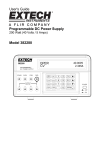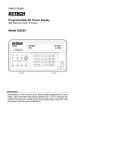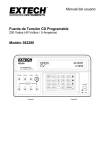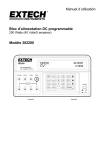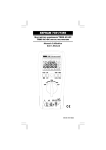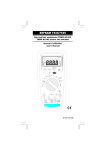Download Extech Instruments 382280 User`s guide
Transcript
User's Guide Programmable DC Power Supply 200 Watt (40 Volts / 5 Amps) Model 382280 382280 Introduction Congratulations on your purchase of the Extech 382280 Programmable DC Power Supply. This 200 watt power supply offers an adjustable 5ADC / 40VDC output plus fixed outputs (5VDC and 3.3VDC). Programming features include custom over-voltage/current protection with delay timer, 199-test storage, and automated testing. Careful use of this power supply will provide years of reliable service. Safety Symbols Please read the statement thoroughly to prevent injury or loss of life, and to prevent damage to this product. Earth Ground Terminal 2 382280-EU-EN v1.9 07/13 Front Panel Description 1. OPER/STBY: Operation/Standby button. Press to enable/disable the output. When the supply is in the 2. 3. 4. 5. 6. 7. 8. 9. STANDBY mode the output is 0 volts. RECALL: Press to call up stored output sets or to activate Automatic Test Sequencing. STORE: Press to save the present V/A output set to memory. Use the numeric keys (not the arrows) to select a storage location from 000 to 199 and then press ENTER. SEC (Seconds): Press to enter time in seconds. Use the ENTER key to confirm entries. V/A: Press to toggle between voltage (V) and current (A) on the display. OCP (Over-Current Protection): Press to enable/disable OCP. OVP (Over Voltage Protection): Press to program the OVP value (defaults to 40V). Numeric keypad and period button. ENTER: Press to confirm entries. 10. ▼ (DOWN Arrow): Press to decrease a programming value. 11. ▲ (UP Arrow): Press to increase a programming value. 12. 13. 14. 15. 16. 17. 18. 19. 20. 21. 22. 23. 24. (RIGHT Arrow): Press to move the cursor to a new location in a row. POWER ON/OFF: Press to turn the supply on or off. Rubber feet. Dot matrix display. GND: Ground terminal (connected to the chassis of the unit). COM: Common terminal for the 5V and the 3.3V output. 3.3V/3A: Positive terminal for the 3.3V output. If more than 3A is drawn, the output will be lower than the 3.3V specified. 5V/2A: Positive terminal for the 5V output. If more than 2A is drawn, the output will be lower than the 5V specified. Positive Terminal for the 40VDC / 5ADC output. This terminal is physically connected to terminal 22. Use terminal 21 (not COM) as the negative terminal for best accuracy. Note that terminal 21, 23, and COM are connected. Negative terminal for 40VDC / 5ADC (terminal 20) output. Positive Terminal for the 40VDC / 5ADC output. This terminal is physically connected to terminal 20. Use terminal 23 (not COM) as the negative terminal for best accuracy. Negative terminal for 40VDC / 5ADC (terminal 22) output. CE (Cancel Entry): Press to cancel a programming entry. 3 382280-EU-EN v1.9 07/13 Operation Preparation for use 1. Place the supply on a flat level surface. 2. Select the input voltage using the switch on the rear of the supply (see diagram above). 3. Make sure the sides and the back of the unit are not blocked. Leave at least 2” (5 cm) of space for good ventilation. Line Voltage Selector Switch Basic Test Setup Diagram Setting and Outputting Voltage and Current NOTE: The 3.3V and 5V fixed outputs are always active when power is turned on. NOTE: The power supply enters the STBY (stand-by) mode when the power is turned on. The output values, time delay, and OVP are the same as they were before the power was turned off. 1. Connect the power supply output to the circuit or device under test before pressing the OPER/STBY button. 2. Check that the displayed voltage and current output settings are as desired. 3. To change the values of voltage or current use the V/A button to move the underline cursor to first digit of the voltage or current display, enter the value directly from the numeric keypad and then press ENTER or: a. Move the underline cursor to voltage or current with the V/A button, b. Use the RIGHT arrow button to select the digit to change, c. Use the UP/DOWN arrow buttons to change the digit value d. Press the ENTER button to select the value. 4. To clear any programming entries, press the CE button. 5. Press the STBY/OPER button to enable the power supply output. Note: If the output goes to zero, the current or voltage limit may be set too low. 6. To change the output values during operation, use the RIGHT & UP/DOWN buttons. 7. The user can monitor the output voltage by connecting a DMM as shown above. Warning: When the unit is placed in STBY mode, the output is 0V; however the output terminals are still physically connected to the internal circuit. 4 382280-EU-EN v1.9 07/13 Over Voltage Protection (OVP) Over Voltage Protection (OVP) allows the user to set a maximum permissible output voltage If the voltage limit is exceeded, the unit will display “OVP” and revert to the STBY mode. Note: The OVP is always active. To be able to set the output voltage to 40V, you must set the OVP to 40V. Setting the Over Voltage Protection (OVP) value 1. In the STBY mode, press the OVP key, “?_” appears in the display. 2. Enter a value from the keypad (range of 0.001 to 40V). 3. Press the ENTER key to store the value. Viewing the Over Voltage Protection (OVP) value The OVP value can be viewed when the supply is switched from the OPER mode to the STBY mode. When switched, “OVP” will briefly appear in the upper display line and the value will briefly appear in the middle of the lower line of the display. Over Current Protection (OCP) Over Current Protection (OCP) allows the user to set a maximum permissible current. If the current limit is exceeded, the unit automatically reverts to the STBY mode. Setting the Over Current Protection (OCP) value 1. In the STBY mode, press the V/A key to move the underline cursor to the A display. 2. Press the OCP key and enter the value from the keypad (0.05 to 5A) 3. Press the ENTER key to store the value. Note: The threshold for OCP is 0.05A. Enabling the Over Current Protection (OCP) Press the OCP button to enable/disable the OCP function. “OCP” will appear in the display when the function is enabled. Over Current Protection (OCP) Time Delay The OCP shutdown can be delayed up to 600 seconds using the SEC function. 1. Press the SEC key. “?” will appear in the display. 2. Enter the value from the keypad (0.01 to 600 seconds) and press the ENTER key. 5 382280-EU-EN v1.9 07/13 Automated Testing Storing Test Setups 1. Set the Voltage and Current values as desired. 2. Press the SEC button and set the time in seconds (1 to 600 seconds). This time will be associated with this step. You need to set the time for each step. Note: The user should set SEC at a minimum of 1 second for the Auto-Step function. If Auto-Step and OCP are enabled at the same time, the value of SEC will be used for the Auto-Step function, while the time duration for OCP will be fixed at 0.01 seconds. 3. Press the STORE button to save the values. “STRxxx?” will appear in the display (where “xxx” (000 to 199) will be the memory location). 4. Press ENTER to store the value in the displayed location or enter a new location number from the keypad and press ENTER. If a three digit number is entered, pressing ENTER is not necessary. Recalling Test Setups 1. Press the RECALL button to view the setup in a memory location. “RCLxxx” and the stored values will appear in the display (where “xxx” (000 to 199) will be the memory location). 2. To view the setup in any other location, enter the setup number and press ENTER. If a three digit number is entered, pressing ENTER is not necessary. 3. Press RECALL to exit the display. Automatic Test Sequencing (ATS) In ATS mode, the unit automatically cycles through a series of stored test setups. The first and last steps are programmable and the sequence will include all steps between the first and last steps. Each test setup memory location represents one step. The duration the step is programmable from 1 to 60 seconds and is programmed when the steps are stored. Note: Initial setup and sequencing should be performed in the STBY mode to verify proper operation without an active output. Setup and Operation of Automatic Test Sequencing (ATS) 1. To set the LAST and FIRST step of the sequence: a. Press the RECALL button. b. Use the numeric keypad to enter the three digit test setup location number for the last step (RCL018, for example) and press ENTER. c. Use the numeric keypad to enter the three digit test setup location number for the first step (RCL001, for example) and press ENTER. d. Press RECALL 2. The time duration for each step is stored with each step in the storing process. 3. To begin the test sequencing, press and hold the RECALL until the beeper sounds and the stairstep icon appears. The sequencing will automatically begin a single cycle through the programmed steps. 4. Observe the output for proper operation. 5. Press the OPER/STBY key to activate the output 6. Press the OPER/STBY to return to the standby mode or press CE to exit the sequencing mode Note: The ATS session will be terminated if any command is received via the RS-232c interface. Note: For continuous cycling, hold the RECALL button while turning power on. 6 382280-EU-EN v1.9 07/13 RS-232 PC Communications Interface RS-232 data format Baud rate 9600 Parity none Data bits 8 Stop bits 1 Flow control none RS-232 Connection Connect the supplied communications cable to the rear of the power supply and to the communications port of the PC. 3 5 9 Power Supply PC Pin 2 ------------------------------ Pin 2 RX Pin 3 ------------------------------ Pin 3 TX Pin 4 ------------------------------ Pin 4 DTR Pin 5 ------------------------------ Pin 5 GND 1 7 RS-232 Commands The command format is as follows: Command Parameter <Carriage Return (cr)> For example: V 20.5 (sets output to 20.5VDC) An ASCII code for <Carriage Return> must be sent together with the command or commands. Commands will not be processed until a <Carriage Return> is received. Note that the unit can process up to 50 characters. If more than 50 characters are received, the unit will clear the entire command buffer. Summary of Commands STBY <cr> OPER <cr> V xx.xxx <cr> A x.xxx <cr> SEC xxx.xx <cr> OVP xx.xxx <cr> OCP 0 <cr> OCP 1 <cr> STORE xxx <cr> RECALL xxx <cr> STEP <cr> ? <cr> V? <cr> A? <cr> OCP? <cr> OVP? <cr> SEC? <cr> STATUS? <cr> (place the unit in standby mode) (place the unit in operating mode) (set the voltage output) (set the current output) (enter time in seconds) (enter desired voltage value for over-voltage protection) (disable the over-current protection) (enable the over-current protection) (store the present output values to memory location xxx) (recall an output setup from memory location xxx) (enable the ATS Auto Test Sequencing function) (retrieve all data) (retrieve the voltage value) (retrieve the current value) (retrieve the status of OCP) (retrieve the voltage value for OVP) (retrieve the time value in seconds) (retrieve the STBY/OPER, OCP, OVP, & 5V/3.3V fixed output status) Note: All commands are case insensitive. 7 382280-EU-EN v1.9 07/13 Example of an RS-232C Program V 20.5 <cr>: program 20.5V A 1.25 <cr>: program 1.25A V 30 A 2 SEC 20 <cr>: program 30V, 2A, for 20 seconds OVP 35 <cr>: set 35V for the over voltage protection SEC 60 <cr>: enter 60 seconds OCP 0 <cr>: disable OCP (Open circuit protection) OCP 1 <cr>: enable OCP STORE 120 <cr>: store current V/A values in memory location 120. RECALL 100 <cr>: recall V and A values stored in memory location 100. RECALL 110 <cr>: recall V and A values stored in memory location 110. Step <cr>: enable ATS function. Starting step is 100 (recalled first in the previous statement) and the ending step is 110 (recalled after step 100). ? <cr> (Inquire all data) V 40.000 40.000 CV A 01.000 00.999 CV OCP 10.00 ENABLE OVP 40.000 5V OK 3.3V OK OPER CV V? <cr> (obtain the voltage value) V 40.000 40.000 CV A? <cr> (obtain the value of current) A 01.000 00.999 CV Note: The first set of data following the character V or A is the programmed value, while the second set of data is the read back A/D value. The third set of data is the status (CV, CC) of the unit. If the third set of data shows 0V, the unit is placed in the STBY mode. The unit sends out a <new line> and <carriage return> after each line of data. TM Using Windows Terminal or HyperTerminal program for PC Communication The Terminal or the HyperTerminal program is included in all Windows Typically it is located using the following path: TM operating systems. START Menu > Programs > Accessories > Communications > Terminal or HyperTerminal When in the Terminal or HyperTerminal program, go to PROPERTIES and configure as follows: 1. In the CONNECT TO field, select COM1 or COM2 (depending on which port is being used). 2. In the CONFIGURATION section, select the following data format: Baud rate 9600, no parity, 8 data bits, 1 stop bit, and no flow control. 3. In the ASCII SETUP section, click on “echo typed characters” and “Send line ends with line feeds”. After Terminal or HyperTerminal is setup, type in the commands as described in the previous examples. 8 382280-EU-EN v1.9 07/13 Specifications Programmed Voltage and Current (after 5-minute warm-up) Range 0 to 40V 0 to 5A Voltage V (C.V.) Current A (C.C.) Resolution 1mV 1mA Accuracy 0.05% ± 9mV 0.2% ± 9mA Voltage and Current Display (Read back) Voltage V (C.C.) Current A (C.V.) Range 0.1 to 40V 0.05 to 5A Resolution 1mV 1mA Display Backlit Dot Matrix (2-line) Display Programmable Voltage Output 0.000 to 40.000VDC Programmable Current Output 0.000 to 5.000ADC Resolution 1mV; 1mA Fixed Outputs 5V (2A) and 3.3V (3A) Memory 200 locations Accuracy Adjustable Voltage: 0.05% ±9mV Accuracy 0.1% ± 12mV 0.2% ± 12mA Adjustable Current: 0.2% ±9mA Fixed 5V: ±0.25V; Fixed 3.3V: ±0.16V Response Time < 150 ms Temperature Coefficient < 100ppm / C o Load Regulation < 1mV / Amp Line Regulation No effect if line voltage is within 90V and 130V for 115V power (200V to 240V for 220V power). Ripple and Noise (0 ~ 40V, 0 ~ 5A) < 3mVrms (C.V.) < 3mArms (C.C.) Open Circuit (OCP) detection Current > 0.05A C.V. or C.C. detection Current > 0.05A Short Circuit Protect When the 5V or 3.3V output is less than 1V (shorted), one of the preceding alert symbols will be shown on the LCD (5V/2A, 3.3V/3A) 10mVrms ~ 20mVrms Power Source 110/220VAC 50/60Hz Dimensions 310 x 250 x 135mm (12.2 x 9.9 x 5.3”) Weight 3.8kg (8.4 lbs) Copyright © 2013 FLIR Systems, Inc. All rights reserved including the right of reproduction in whole or in part in any form ISO‐9001 Certified www.extech.com 9 382280-EU-EN v1.9 07/13









